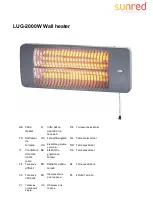
Model LD Pool and Spa Heater
Page 9
mend outdoor shelter installations that depend on
internal air for combustion. Combustion air should be
ducted to the heater from outside the structure.
Outside Air Supply:
When combustion air is
supplied directly through an outside wall, each opening
should have a minimum free area of one square inch
per 4,000 BTU/h (1.2kW) input of the total input rating
of all appliances in the enclosed area. If air is provided
through horizontal ducts, each opening and duct must
provide one square inch of flow area for each 2000
BTU/h (0.6 kW). These requirements are summarized
in Table 3. Note that the areas specified are net free
areas and should be increased by 50 percent when the
openings are covered by screens, louvers, grills or
other protective covers (see Figure 4 and Table 3).
Note:
In Canada, follow Canadian Standard, CAN/
CSA-B149.1 or local codes.
Exhaust Fans or Vents:
Any equipment which
exhausts air from the room where the heater is
installed can deplete the combustion air supply or
reverse the natural draft action of the venting system.
This could cause flue products to accumulate in the
room. Additional air must be supplied to compensate
for such exhaust.
The information in Table 3 is not applicable in
installations where exhaust fans or blowers of any type
are used. Such installations must be designed by
qualified engineers.
If a blower or fan is used to supply air to the
room, the installer should make sure it does not create
drafts which could cause nuisance shutdowns of the
pilot.
The heater must be completely isolated and
protected from any source of corrosive chemical
fumes such as those emitted by trichlorethylene,
perchloroethylene, chlorine, etc.
WARNING
Do not store any chemicals, cleaners, or other
corrosive material near combustion air openings or in
the room. Avoid locating dryer vents in the vicinity of
combustion air openings. Failure to prevent corrosive
materials from mixing with combustion air can result
in reduced heater life and unsafe heater operation.
AVERTISSEMENT
N’entreposer aucun produit chimique, produit
nettoyant ou produit corrosif à proximité des bouches
d’air de combustion ou dans la pièce. Éviter de
placer des tuyaux de ventilation pour sécheuse à
proximité des bouches d’air de combustion. Le fait
de laisser des matières corrosives se mélanger à l’air
de combustion risque de réduire le cycle de vie de
l’appareil de chauffage et de compromettre son
fonctionnement.
3.2 Vent Pipe Sizing and General
Installation
3.2.1. Outdoor Installations
For outdoor installations, exhaust venting consid-
erations will determine the placement of the heater
(See Section 2.3.4). If the heater cannot be placed so
as to meet the requirements stated in Section 2.3.4, a
vent pipe and cap may be added to the heater to move
the exhaust vent opening to a position that complies
with the requirements. When the heater is installed in
areas of high wind or when unavoidably installed near
a vertical obstruction where downdrafting may occur,
it may be desirable to add a vent cap directly to the top
of the heater. In all cases, vent pipes and caps must be
of the same diameter as the exhaust outlet of the
heater. Approved vent caps may be obtained through
your Jandy distributor.
3.2.2. Indoor and Outdoor Shelter
Installations
WARNING
Vent pipe diameter must be as required by the
National fuel Gas Code ANSI Z223.1 or the Canadian
Installation Codes for Gas Appliances CAN/CSA-
B149.1. Undersize pipe can result in inadequate
venting and oversize pipe can result in vent
condensation. In either case the result can be
release of combustion products to the indoors. This
can cause serious injury or death by carbon
monoxide poisoning or asphyxiation.
AVERTISSEMENT
Le diamètre des tuyaux de ventilation doit répondre
aux exigences du
National Fuel Gas Code
ANSI
Z223.1 ou du code canadien des installations des
appareils à gaz CAN/CSA-B149.1. Des tuyaux trop
petits risquent d’entraîner une ventilation inadéquate
et des tuyaux trop gros risquent de provoquer une
condensation dans les tuyaux. Dans un cas comme
dans l’autre, des produits de combustion risquent de
s’échapper dans le bâtiment et causer des blessures
graves ou l’asphyxie par le monoxyde de carbone.
All indoor installations and outdoor shelter
installations require the addition of a factory approved
drafthood. The drafthood must be installed without
modification.
All vent installations must be made in accordance
with all local, state or provincial codes and with:
1.
The section covering "Venting of Equipment" in
the national Fuel Gas Code, ANSI 223.1 latest
edition, or the applicable provisions of the local
building codes.
2.
In Canada, The Natural Gas and Propane
Installation Code CAN/CSA-B149.1 applies.
Содержание Lite2
Страница 1: ......
Страница 20: ...Page 18 Figure 16 LD Connection Schematic Wiring Diagram ...
Страница 37: ...Model LD Pool and Spa Heater Page 35 Figure 23 Trouble Shooting Test Points ...
Страница 44: ......












































